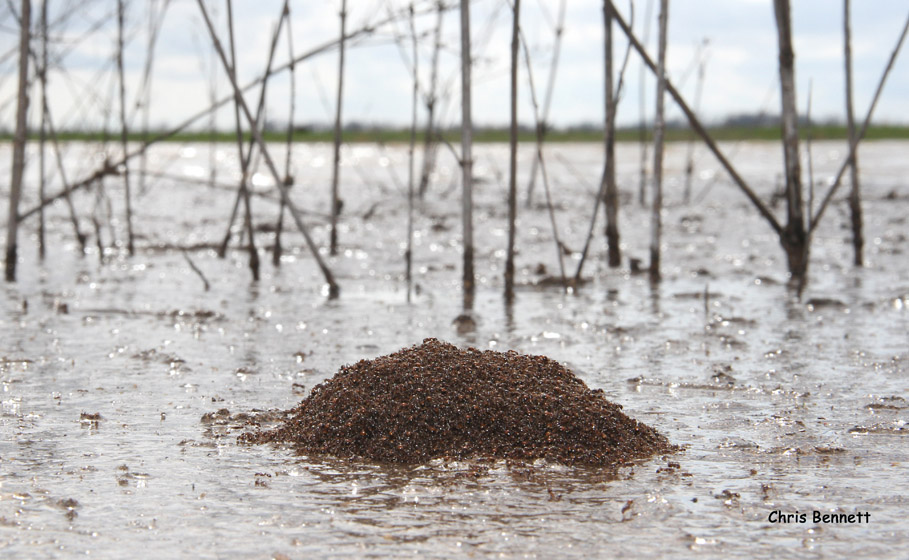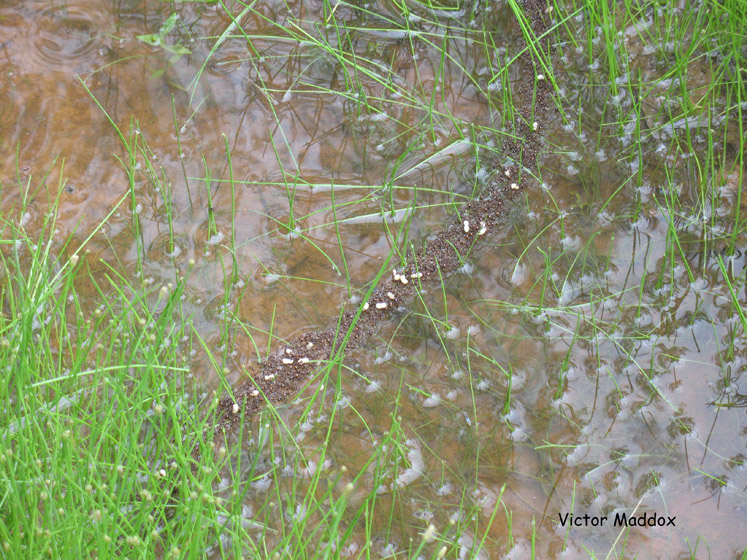Fire Ant Facts
- Fire ants first entered the United States about 1918, near Mobile, Alabama.
- Fire ants reached Mississippi around 1930.
- Fire ants now occur over much of the Southeast. [USDA fire ant quarantine map]
- Northern migration of fire ants will likely be limited by cold—winter temperatures that freeze the soil deeply enough to affect overwintering colonies.
- There are two species of fire ants in the state. Red imported fire ants are the most common, but some areas have black imported fire ants, or hybrids of these two species. These two species are similar in biology and behavior.
- Fire ants are social insects that nest in the soil in large colonies that contain tens of thousands to more than 200,000 ants.
- Fire ant mounds may be taller and more durable in certain soil types, such as heavy clay vs sand
- During cold, wet weather fire ants tend to maintain their colonies high above ground—to keep brood out of water logged soil and to take advantage of solar heating.
- During hot, dry weather fire ants tend to maintain their colonies below ground—to take advantage of cool, moist conditions.
-

Fire ant colonies can survive flooded conditions by “rafting,” and will establish a new mound wherever they happen to make landfall.
(Photo courtesy of Chris Bennett) -

When forced to relocate, worker fire ants will use their bodies to build a bridge across narrow expanses of water to allow safe transportation of brood.
(Photo courtesy of Dr. Victor Maddox) - Most of the ants in a fire ant colony are infertile, female workers.
- Worker fire ants vary in size, but all are capable of stinging.
- Usually there is only one queen per colony. The queen lays the eggs.
- Fire ants have a complete life cycle. The eggs hatch into legless larvae, which develop into pupae and ultimately become adults.
- Fire ants feed on a wide range of foods, including insects, honeydew, plant nectar, seeds, fruit and animal carcasses. They especially like foods high in fat.
- Foraging workers exit the mound through underground tunnels that radiate away from the mound, exiting to the surface five to 25 feet away from the mound.
- Adult fire ants are incapable of swallowing solid food. They have to carry it back to the mound.
- Solid food is fed to the larger larvae, which chew and digest it and regurgitate it in liquid form.
- Liquid food is passed from the larvae back to the workers and then shared with all ants in the colony.
- Fire ants spread by swarming. Unmated, winged reproductive male and female ants exit the mound in mass, fly into the air and mate while airborne.
- Newly mated fire ant queens fall back to the ground within a few hundred yards to a few miles of the mound from which they emerged, shed their wings and attempt to start new colonies.
- At first the new queen is ‘on her own’. She lays a few eggs that eventually become small workers. These first workers then help care for their younger sisters and the colony begins to grow.
- It takes several months for a colony to get large enough to build a mound large enough to be noticed in the average home lawn.
- For every large mound in a lawn there are usually many younger colonies that are still too small to produce visible mounds.
- Once a young fire ant colony is well established and has a few thousand workers, it can quickly develop into a mature colony containing tens of thousands of ants.
- Small colonies develop into large colonies especially quickly if there are no bigger colonies nearby to compete with them.
Contact information for Dr. Blake Layton.
Publications
News
Sunshine and long days make summertime in the South desirable for people, but those same conditions are exactly what allows the dreaded, imported fire ants to thrive.
Almost any sunny, grassy area left unattended will soon be home to fire ants. Fire ants were accidentally imported from South America to Mobile in the 1930s and have since spread throughout the Southeast.
Everyone loves a good myth buster, and we have a very timely one for you! Fire ant beds in your yard can be such a headache to deal with. Many people have used home remedies to control ants. But are those quick fixes really getting rid of the ants in your yard? Let’s take a look at some commonly used home remedies and whether or not they work!
Do you have fire ants in your vegetable garden? Me too. Good news for all of us! There are some fire ant baits that are safe to use around food plants.




